|
PACKING GOATS
Training Your Goat To Pack
Goat Packing and Packing Goats can be a ton of fun for the humans and the goats when done correctly. Pack Goats can be a joy to own. But don't over burden your pack goat with too heavy of a pack, or neither of you will have a good time.
This page is still under construction, more of a work in progress if you will, so check back often please.
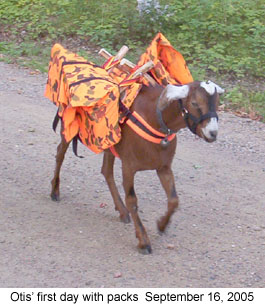
Goats make wonderful packers and companions on the trail. They are, what we would call in today's world "Going Green", or in the 70's "Low impact" on the trail. Their foot prints are light and leave little trace. Their feces is good for the soil and plants around them.....however, in some areas you may have to feed a certain diet or they may not even be welcome, for the seeds in their feces.
Most goats are very easy to train to pack. Others may never be suitable for taking on an overnight trip...more trouble then they are worth.
Weathers (castrated males) make your best packers, but don't rule out the does, even those that are milking can be fun and carry on the trips you make. Milk does will provide fresh warm milk for you on the trail. Wonderful to cook with. Just be sure you bring a container to milk her out.
The smaller goat breeds can sure go on a pack trip. They will of course not carry as much a Dairy or Meat breed. The little guys packs also need to be their size. Otherwise, all the information below pertains to their breeds too.
JUST REMEMBER! THERE IS NO PLACE CALLED "IN THE WOODS". ALL WOODS, ALL LAND, IS OWNED BY SOMEONE. MAKE SURE YOU HAVE PERMISSION TO BE ON THAT LAND. IF IT IS A PARK, YOU WILL STILL NEED TO MAKE SURE GOATS, CAMPING AND CAMPFIRES ARE ALLOWED!
HOW TO READY YOUR GOAT FOR A PACKING TRIP
Your packing goat needs to be in good health and good shape. Not only should your goat be healthy, it's hooves need to be trimmed correctly and neatly and not done the day just before the trip.
Your goat needs to be on a regular worming schedule and kept healthy and well fed. Not overfed, well fed.
The goat's age does matter! A young goat, one year old or older, can carry a light weight day pack, but certainly not a heavy weight, overnight sawbuck pack with panniers. It is not a good idea for a goat younger then one year old to carry a pack. By the age of 3 1/2 years old you goat, if worked up to the weight of the load and miles you will be traveling, is ready to carry a sawbuck.
By the same token it is not a good idea to start a goat's packing career when it is older the seven years old. A light pack would be OK for a short trip. By seven years old your goat is what we call "middle age". At that time your goats body, especially if it has not worked before) will not be as resilient as it once was.
Goats carrying heavier loads need to be worked up to it. Just as you would not suddenly carry a 50 pound pack for 10 miles, it is not fair for the goat to have a large load stuck on it's back and asked to carry it for miles.
Start with a light or empty load when first training your packing goat and just walk about a block or so. Take your goats around tress so that they learn to swing out away from them with the pack on. Take your goats up and down hill so they get the feel of the pack moving on their back a bit as well as learn to balance a bit different. Make a fuss over your goat as it carries the pack. Make it believe it is the KOOOOOLEST animal in the world! Back those words with treats.
Keeping your goat in good condition is important. Grooming your goat, brushing it out and picking it's feet, before and after it carries a pack, will help the goats muscles, help you find any cuts or bumps or dry patches or bugs, it will also be a little reward for the goat. It will remind the goat that you appreciate it's efforts.
BASIC LEASH TRAINING ~ TEACHING YOUR GOAT TO WALK ON A LEASH If you are going to be taking your goats off your property, you will need to leash train them, even if they "stick to you like glue". Most places you will want to visit and Pack in will ask you to keep your goats on a leash or lead rope. I will warn you right out of the box:
1. Working with bottle fed babies is so much easier then working with doe fed kids. I have worked with both bottle fed and doe fed kids, and it is harder to get the attention of the Doe Fed kid, for sure.
2. The younger you start the kids the better.
3. Work ONE kid at a time. Get them to bond with you, not the other kids and or goats.
4. Work your kid several times a day. Be patient. Be kind and loving.
5. Buy a small, soft, equine brush and brush you kid before and after you walk them on a leash (or work with them) this translates, motherly grooming to them and like when someone brushes or plays with your hair, it feels good and calming.
6. Be firm, but do not yank or choke your kid as you teach it to follow you and walk with you on it's leash.
If you are working with a bottle fed kid, or goat, the leash will mean little to it. The goat will follow you just because it sees you as the Milk Truck, the Alpha, the Mother. Leash Training a Bottle Fed Kid is as easy as clipping the snap to the goat's collar and taking a step, then walking.
If you are working with doe fed kids you want to start working with your kid goats several times a day. Don't feed them and leave the area. Feed them and stay right with them, hold the bowl, or feed it/them out of your hand. Then after a few days, after they calm down and see you as the "food truck", as animals see their mothers, start hooking them on leashes and walking forward for food from your hand. That should get you started.
They are going to resist. They ARE goats. Just talk to them sweet and be firm but not yanking or choking on the leash. Walk a few feet and pull them along, talk sweet, say "Gooooood". If they start taking steps WITH you, say "GOOD", "Gooooood" and "Gooood". Give them a treat. Pet them. Make a fuss. Then repeat.
Soon the goat will understand what you are asking it to do. It will also understand that it gets rewarded when it performs the task you are asking your goat to do. We call this "learning to learn.".
TYPES OF PACKS
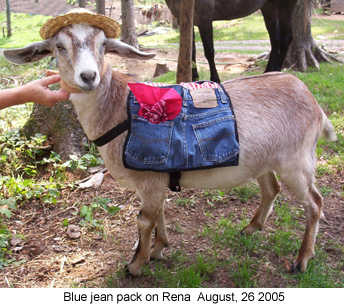
There are many types of packs that goats can wear on the trail. The choice comes down to the type of packing you need for the current trip you are taking with the goat. The type of packs you will use may also be determined by how many goats you are taking with you and how much of the load you will be carrying (if any).
For a Day Trip, just a couple of hours with maybe lunch on the trail, a soft sided Day Pack without a saddle pad can be used. For and overnight trip you might want nice sawbucks with large panniers and a nice thick saddle pad under it, so that you can tie your sleeping bag to the load.
However, if this is your first, second or third trip out with your animals, you might just want to take Day Bags, or borrow the (large) dog's backpacks, to give packing with goats a try.
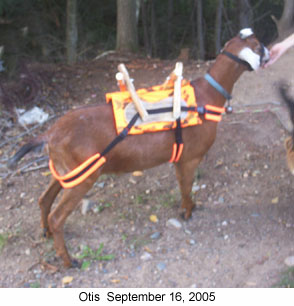
I do have a page at this site with the different packs shown. Have a look to see the many types that a goat can and do wear.
Another way of choosing your pack will be how much money you want to spend. If you have a large amount of money to spend, then by all means get the best. Get a Sawbuck type with a nice thick blanket and a big ole first aid kit. Just remember, the most expensive is not always the best. "You get what you pay for" is true but not the rule of thumb. You can buy and nice pack for your goat that will take you many miles with a meager budget.

Something to keep in mind above all is your goats build. If you are buying a pack for a Dairy sized or breed goat, do not buy a pack made for a Pygmy goat because it is cheaper and you think it might work.
Some large sized Dog Packs will work for a Dairy Breed goat, but not for all of the goats in the dairy breeds. You might be terribly disappointed to find out that the Newfoundland dog sized pack you bought is just waaaay too big for your goat. You need to measure your goat, especially if the goat is odd sized. Long backed, big barreled, or the like.
The best thing to do is talk to people that are packing with goats. Talk to folks that are doing the same type of packing you want to do. In other words, week long goat packers are using different equipment then someone going out for a two mile lunch trip.
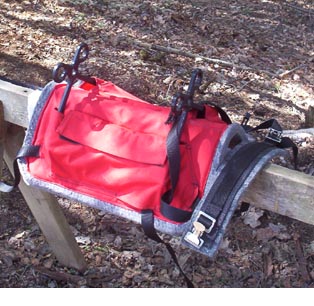
If you are going to take your goats on several overnight packing trips you will want the sawbuck type packs. There are several types of sawbuck saddles within this catagory. This is why I am telling you to talk to folks that use them.
One thing all sawbuck saddle packs have in common is that they use panniers. Panniers are the pouches/bags/purses that hook or tie to the saddle. These panniers come in different sizes, fabric types, colors, with different closures and abilities to tie outside stuff to them.
Before spending the money to buy a pack you will not be happy with, do your home work. Read up on each of the packs, as I said talk to people (use a Yahoo Groups list for this, one like Cart_Wagon_Goats) and by all means, get the panniers you will be happy with. Goat panniers, when empty at a camp site, can become your pillow for the night (fill with clothing).
You can surely take a goat on an overnight trip with a day pack. You just will not be able to pack it with as many items in it as you could pack into a sawbuck type saddle with the goat's spine health in mind. You will also not be able to tie onto the day pack. But it will sure get you started to see if you even care to have a goat in camp or as a trail companion.
But here is the bottom line about buying your goat packs. Get the one YOU like for YOUR goats!
PACKING THE PACK
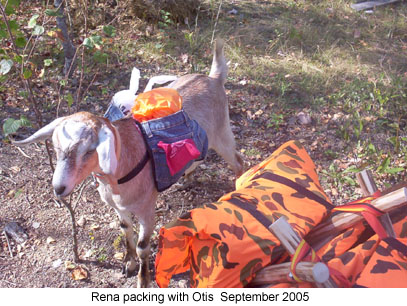
Rule number one: KEEP THE PACKS EVENLY PACKED WEIGHT WISE.
Rule number two: NO SHARP ITEMS ON THE INSIDE (near the goats body) OF THE PACKS.
Rule number three: DON'T OVER PACK THE PANNIERS.
It is so important to keep the above three rules in mind when packing with animals. If the packs/panniers are not even in weight one side will pull the other either over or off balance. You may even loose the load.
I am sure I do not even need to explain why you do not want sharp or hard items poking your goat in the side with each step it takes. Pack soft items, such as your clothing, next to the goats body.
Have you ever carried a pack that was tooooo heavy for you? Not only is it hard on your body, it will ruin the trip for you. If your burden is too heavy while packing you will not be able to enjoy the fun things on the trip because all you will be thinking about is how heavy your pack is and how much your body hurts because of it.
The same is true for animals. A heavy load is a burden. A load that is too heavy will not be fun for the animal and therefore, not fun for you. Injuries on the trail are certainly serious. Keep in mind that if your goat is overloaded and injured, YOU will be carrying the goat's pack the rest of the way or home.
Don't pack breakables or sodas or apples or bananas or the like in your goats pack. Surely, I do not have to explain why, right?
You also do not want to stuff a pack. Over packing is not only hard on the goat, it may cost you in split seams, lost items or torn panniers.
A backpacker's rule for packing is not to take anything you do not need...on the other hand, when you pack with animals, you can take those extras you always wish you had out on that trip.
WHAT TO PUT IN THE PACKS
When out packing with animals what you carry is usually decided upon where you are going and how long you will be staying. Of course if you are camping you will need many more items then if you were just going out for a lunch trip. There are some items however that you should always take with you.
I have backpacked with dogs (both the dogs and I wore packs), goats, llamas, horses, our donkeys and of course my wonderful husband who always made the trips lot of fun. While out packing when we have run into other people they always ask "What is in the packs?"
This is a list of items I carry in my packs, no matter what species of animals I go packing with, this is what I carry. I will be adding a list of items that will prove necessary while hiking and camping in the back woods soon, plus what is in my first aid kit.
 What I carry IN the panniers when I go backpacking
First Aid Kit
Duct Tape
Small Sewing Kit in thick plastic container that closes tight with at least two needles as well as light and dark thread
Extra socks in a zip lock bag
Extra Gloves in a zip lock bag
Small Paper Pad and Pen
Binoculars
Small Cook Stoves
Stove Fuel (wait til you see my new one Deron made 
Fire Starter - we use pinecones dunked twice or three times in hot wax, then packed in waxed paper to travel
Matches dunked in wax to keep them dry
Lighter
Space Blanket
Sit Upons (packed next to the goat for cushion)
Folding Lawn Chair
Pots and Pans
Pot Holder of some type
Cream and Sugar, Instant Coffee, Tea, Hot Cocoa, Tang (yes, I do take them all, ever had Tang Hot?)
Plastic Insulated Cups with caps/tops
Plastic (the kind that you get at camping places that don't brake) silver ware
Tie Outs for animals
Pillow Case (for sit upons to be tucked in for pillows)
Camera
Flashlight (I carry two, one is the lantern type)
Leatherman Pocket Tool
Wet Wipes in a zip lock bag, doubles as toilet paper, well, not doubles but can be used as
Hand Sanitizer
Water
Water Bowl or Frisbee for animals to drink out of
Water treatment (for treating iffy water before drinking or serving it to people or animals)
Tarps - at least two (you will want nicer ones)
Rope for many things including tying up food or wet clothing
Trowel or small shovel
Small Bible
Book
Reading glasses in hard sided case
Recorder and/or Ocarina and music
Safety Whistle (usually around my neck)
Safety Pins in several sizes - carried in sewing kit of course
Goat (dog, or any animals with you) health papers and or proof of ownership papers
CASH, tuck a bit of money in your pack, not a lot, just a few dollars, you may never need it, but you might
Empty plastic bags to load dirty clothes, trash or trail finds into
Clothes Pins (at least three)
Rocks, yes, rocks
keep reading down the page for more ideas on what to carry with you on a pack trip
I know that I carry more... that's all I can remember of right now.
The Bandanna, what an important piece of hiking, camping, jogging, horse back riding, sports equipment it is. It can be used for so many things and it might even become your life line.
I always carry a few. I put at least a couple into the backpacks/panniers as well as put bright colored ones around my animals necks for visibility. Many times I wear one myself, either around my neck or around my head, in a triangle, scarf style, to keep my ears warm and the wind out of them. You can also roll it up and use it around your head for a sweatband. Or even use it to pull back long hair into a ponytail, or make a "skull cap" out of it as a hat.
A bandanna can be used as a wash cloth, dry it out and put it around your neck to keep you warm, you can simply use it, wet or dry, to wipe the sweat off your face or dampen it to get the dust off your clothes. It can become a sling for a hurt arm, a band aid, use it as a tourniquet, a leg wrap for animals or it can be used to hold splints to a broken leg of animals or humans.
It can become an extra collar for your animal or even repair some holes in packs (double or triple the bandanna over and set it into the place where the hole is in the pack).
You can put a bandanna, stage coach robber style, in a wind storm or snow storm. It will keep the dust and or snow out of your face. Use it as a neckerchief to keep you warm or to keep the hot sun from burning you.
Your bandanna when rolled or scrunched up, can become a pot holder or a cushion for a bucket handle that the plastic broke off of. You can use it for a napkin at dinner or to blow you nose in or cough into.....don't use it for your nose then a napkin....see why I take more then one?
Something else that is really fun is to teach your goat to bring you the bandanna (as a trick, see the trick page here at this site). You can dazzle your friends with the trained goat....have the goat bring it too you off the ground, out of someone's back pocket, from a distance....
You can also make your own bandannas with fun and even goaty prints. When looking at fabric in the fabric store double up a corner (triangle shaped) of the cotton (or cotton blend) print you like and that is how much fabric you need. That doubled piece of fabric in your hand will make two (four if you cut out the triangle) bandannas.
A FEW ROCKS AND ABOUT SIX CLOTHES PINS
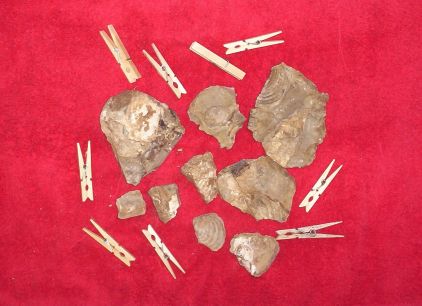
Yes, I am serious. What would one do with these on a goat pack trip?
Rocks that you use should be of different sizes, from one or two the size of your fist, and a couple a bit smaller. These rocks can be used for balancing your loads on the goats back. Why take them with you? If you would ever pack in a place like I live, where, believe it or not, there are no rocks, you will need them. Most places however, you can pick up and delete the rocks for your pack as needed. If you do carry rocks from home, take some pretty ones or fossils or something else fun and interesting.
If you carry rocks for this purpose and are thinking how would you carry them in the pack you have them in and use them for balancing, remember that you will be moving items around and eating out of your packs. The weight will change from time to time.
The clothes pins are wonderful to have on a packing trip. The longer you are on that trip the more uses you will find for clothes pins. I like the snap type. You can hold chips closed with them, hang wet clothes on lines or small branches, and hold down papers on a windy day. Clothes pins can hold your jacket to a lawn chair on a windy day, and a whole lot of other things. And if you are the joking sort, well, clothes pins open a whole other ream of fun things to do.
If you are clever, have art talent and time, you can paint or sketch a cute goat or goat packing or other art on your clothes pins.
There are many uses for tarps while packing, even on just a day trip. The longer you will be out on the trail with your animals, the more tarps you might want to carry with you.
You will of course want to put one under your tent. Depending on the weather and or area you are packing in, you may want one for over your tent. You can place one over the front of your tent (think front porch/shade). Tarps are great for laying out on the ground to set all your items on.
Tarps can become tents for goats for either rain or for shade.
more to come
Other Ideas of Items You Might Want To Pack Suntan Lotion
Sunglasses
Baseball Cap or Sun Bonnet
Neck Coolers (fabric/bandanna type collar filled with expanding pills that you soak in water then wear)
Change of Clothing (obviously for overnight, week end or longer trips)
Pistol
Guitar
Wine wrapped and cushioned and in an insulated container
Bug Spray - I use Skin So Soft by Avon (no I do not sell it)
Camp Lanterns
Camp Flags (small are recommended)
Folding umbrella for sun and or rain
Skunk Odor Remover
Bear Spray
This is like asking folks what their favorite type of blanket is, or how firm/soft they like the pillow, or do they have to sleep in silk pj's.... You need to take the least amount of items you will need for a good nights sleep. Items to consider...
Sleeping Bag
Sleeping Pad (air pump for same if needed)
Pillow or something that acts as one
Tent (and don't forget the tent pegs)
pj's (if you just must have them to sleep)
your dog or other person or stuffed animal to snuggle up next to
Special Blanket (usually in stead of a sleeping bag)
you get the idea <smile>
Remember to keep your flashlight under your pillow, check batteries before dark. You might want to wear a watch, you will probably be checking it. If you have a weapon, you will want to know right where it is in it's safe place too. Before dark also put the bells and or reflective items on your goats.
Here's another spoon that can stir a very heated debate. But it comes down, in my opinion, to one thing....do you know how to use that gun/sword/knife or what ever weapon you chose? If you do not know how to use it, and use it safely, you are more likely to hurt yourself or one of your friends and or animals with it and you should not have it with you.
On the other hand, a pistol can be a life saver out on the trail or in camp. Bear, wolves, coyotes, big cats and other predators can not even pronounce gun control, or give a hoot about politically correctness. And the two legged sort, out to cause trouble, are hoping that you do know all about gun control and or politically correctness and follow each to the Tee.
Big Dogs are usually the best and most effective line of defense out on the trail. I used to pack alone (no other people that is) in a pack in St. Louis county, MO with my dogs. Joggers used the trail as well as bikers and other hikers. When alone out in the woods you never tell a stranger your big ole friendly dog will not bite, tell then what I always did "Just don't make any fast moves or try to get near me." With five Black Labrador Retrievers on leashes each carrying a hunter orange pack, I was safe. There were two known lone females that were sexually molested by "a jogger" on the same trails. (Why do they continue to wear almost nothing and jog in the woods, it is beyond me!)
Large pocket knives can also be used in defense if you know what you are doing. If not, you will just get a very nasty cut on your hand.
When you are hiking/packing, you must have water for yourself and for your animals. You may or may not find drinkable water at your or on your way to your destination. Try to find out about any new areas you intend to pack in. Water is heavy and you will not want to carry much, but you should always carry some. Some animals may not drink water if it tastes "funny" to them. Most will, but you should know that yours may not.
You can carry filters, or pills to put into the water you find or you can carry iodine, or you can carry a bit of bleach, or you can spit in the water in a magic bucket and turn around three times repeating "be clean, be clean, be clean".....ok the magic bucket and "be clean" thing will not work and I was of course joking. But my point is the same, be prepared. You must have water for yourself and for your animals. You should carry something at all times to clean the water you find....but you should also know how to use them.
There is this wonderful item on the market that I really advise any packer or hiker to own, it is a collapsible water bucket. You can get them in different sizes and colors.
more to come
When I started racing, training and packing with sled dogs and camping much, I started carrying (at all times) in my pockets the following items. You never know when you will need them and need the quickly. My husband and I moved to the country, now out on the prairie and have many animals....so having some of the items on our person could be a life saver. I worked in a key shop years ago and learned from people that came in to have extra keys made that carrying extra keys is a must. I always have two sets (one small) in my pocket. Many times I also carry a vehicle set in my animals pack, that way if I am separated some weird way from my keys that are on my person, I can still drive home.
Large Seraided Pocket Knife
Lighter
Back up Keys for the important things, vehicle, house (keychain used to be screwdriver)
I wear reading glasses, so I carry a conchabon (a domed glass coin like item about the size of a quarter used like a magnifying glass, but set on the paper/price tag
matches (yes, along with the lighter, one might work when the other does not)
small (tiny) flashlight that I keep the battery fresh in - I have used this many times
chapstick
cash, of course
and this little bitty Horner Harmonica (if you are ever in a disaster it can be heard with less body energy then yelling for help) that is fun to pull out and blow in while out alone with the animals....once in a while it will calm or quiet them
It might seem like a lot, but when you are out taking care of your farm and animals a trip back to the house can be an issue...and you might need the items fast. I also, in the winter, carry a break and shake hand warmer. I can not tell you how many times I have pulled these small items out of my jean pockets and used them....much to many people's surprise and delight. LOL
Speaking of Pockets.....I also carry a crocheted headband, to warm my ears, as well as gloves, in my jacket/coat pockets. I have break and shake hand warmers in each pocket. Be prepared, better to have a little more in your pockets then you might need. Because if you need it, it won't seem like a bulky or unnecessary item at all.
HOW MUCH WEIGHT CAN A GOAT PACK?
Most of the time the answer is 25% of their own body weight. Have you ever thought about how much 25% of their weight is?
When I started packing with animals I started with dogs. I was told that, and read that (in more then one book) they could carry 25% of their body weight. So if you have a 100# dog, it can carry 25 pounds????? Not my dogs, not my animals. Then, if you think about how people fatten up their animals in today's world it really gets bad..........so say you have a goat that is suppose to weight 125 pounds, but you like to grain it and give it treats, so it really weighs, say 160? Now, by reading that a goat/animal can carry 25% of it's weight....... see where I am going here?
So I beg you! Before you put that amount on the backs of your animals, pick up 25% of your own body weight, throw it on your back and walk around the house. Seriously. If you weight 100 pounds, take a 25# bag of animal food and rope or belt it to your back......having fun yet? Try the stairs. You might say that the animals have four legs and it balances out better then two legs....well? That is true, BUT it is still the same amount of weight on it's back.
To me, I would rather have an animal to pack with for many years rather then one that will not be able to pack other then 5 years (just grabbing a reasonable figure here) If you over pack an animal, they will suffer health problems. I guess I am just too soft.......but I have backpacked with
animals and packed with horse for many many many hundreds of miles......and we all had fun!! But then, I like taking multiple animals with me on the trail. More animals, less weight each has to carry. Less I have to carry.
So how much do I pack on my pack goats? Probably 10 - 17% per goat. And don't forget, the pack and sawbuck and or whatever else you are putting on the goat (like a folding chair or sleeping back or pad) need to be considered in the total amount of weight that the goat is carrying on it's back.
SECURING THE LOAD
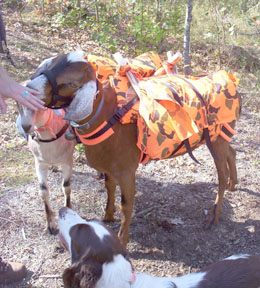
Your load on the back of the animal will rock wildly if not secured. For a Day Pack or Soft Sided Light Weight Pack it should not be a problem to have the bag just closed and unsecured. But for a large load the rocking can sore up your animal. It can cause saddle sores and make the goat's muscles sore for days.
Some packs can easily be strapped down by adding one strap around the girth, over the packs, of the waist of the goat. Some systems have securing straps within the saddle.
I found out the hard way that if your panniers do not have a closure, you will need to secure them with an over he back strap. Otherwise items can work up to the top and fall out of the pack when you are not looking. (I lost and earring, out of my ear, that same day. Amazingly my packing partner, Sally, found it a year later. It was her property we were packing on.)
Always check your load while on the trail. Keep an eye on your animals as well as actually checking the pack to make sure the straps are snug, the pack is even, the goat seems comfortable.
USING MORE THEN ONE TYPE OF PANNIER FOR YOUR GOAT SAWBUCK SADDLE
One really nice thing about a Sawbuck Goat Saddle is that you can have/own different types, styles, sizes of panniers for that same saddle.
You might not want to use your quiet Bright Orange Polar Fleece Hunting Panniers for when you go out rock or fossil hunting. On some of your day trips you might want to use an easy assess open top pannier, rather then the great big double zippered panniers that are really made for week long trips.
For parades and or other public displays you might want to own a set of panniers that are new and nice and maybe even Holiday Print rather then the set you have "broken in" for years out on the trail.
You can even use tote bags draped over your saddle with the right load. You want to be careful using these so that nothing falls out. This type of pannier would be more for rock hunting, lunch trips or light town shopping.
Another idea is to use a set of inexpensive horse saddle bags as panniers over a sawbuck. They would probably need a "tuck" seam between the bags or they might hang too long. Or you could cut them apart and add straps to fit your sawbuck. You could use the strings that normally tie the bags to the saddle, to tie to the sawbuck.
Many people (I am one) also use small insulated fabric cooler packs. You may find some for a song that work out just right for your shorter or even longer pack trips. With premade insulated fabric coolers and or premade tote bags you may need to rework the straps to fit your pack sawbuck saddle.
LEAD OR NO LEAD?
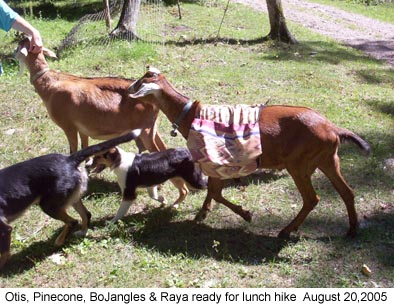
You should always have a leash or lead with you when you pack with your animals. If they do not wear a collar carry a halter with you or have one on the goats as you pack.
If you are lucky enough to own your own property, or know the property owner personally; If your goats follow you faithfully, then you will not need a lead rope on your goats.
If your goat does not stay with you, or if you are on City, County or State Property it is best to keep your goat on a lead rope or leash. I think a halter is best for leading a pack goat, especially on City, County, or State property.
Most goats, all most all packgoats will follow their person or the people that will feed them, right along on the trail. Most will line up single file when the trail is a path. If you are walking on gravel roads, logging roads or the like, you goats might spread out next to one another. The truth is most packgoats, like or maybe better then, a very loyal dog, will stay right with their owners at all times when allowed to (out of the pen).
GOAT BELLS
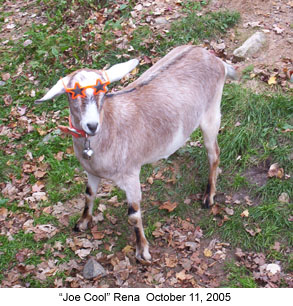
Does your goat wear a bell at home? Mine do, so when we load up, the bells are already on them. A few years ago I had all of my goats in these wonderful sleigh bells. They have/had the nicest tone to them. Well, you know how it goes, one lost here, another goat shows up for lunch without it's bells and so fourth. So I have a couple of those left. Then I have some goats in sleigh bells that are not as nice sounding, not that they are bad, just not as pleasant toned. How I wish I still had everyone in those bells. When my goats came running when I called them, it sounded like the reindeer that Santa uses for his sleigh coming. If you look at most of my photos you can see the small bell with the nice toned big ring.
Some people do not like bells on their goats when packing, they like to hear the quietness of the trail. Other people like the bells cause it keeps bear and big cats away and they know right where their goats are. Either way, you can still have bells on your goats at night.
If you put bells on your goats at night you will be able to hear them, if they are moving around, if you wake up and worry. If your goats get spooked during the night the you will be awakened to the sound of the bells and can investigate what is going on. And if get up on the morning and the goats that you left loose are gone, having bells on them should make them easier to find.
You can use any type of bell you choose. If you are going with a group you will not want a big ole cow bell. Choose your bells by testing the tone. Do you like the tone? Does the tone annoy you? If you have more then one goat are the bells just too loud when they are all ringing? I took those cheaper Christmas sleigh bells and put four on a parachute cord to make them a bit louder then just one. The tone is not too bad (not like my first sleigh bells LOL) and they are not too loud or annoying. I also have a few of those smaller swiss toned bells that I will be using for upcoming goat bell wearers.
I can now tell my goats apart by the tone of the bells. But I tell you, I still am lamenting loosing those sleigh bells with the nice sweet Santa reindeer bells. I will keep looking for sure.
You can put your bell on your goat's collar, that's where my goats wear theirs, or on their halter. If you are only using the bell while hiking you can attach it/them to your pack. You can attach the bell/bells with cord, a slip ring key chain, attach the bell to a snap, such as a dog snap so that you can take it off and on quickly, or if you bell is on leather, slip it through the collar.
OVERNIGHT TRIPS
Overnight trips take much planning. You will need to plan not only what you will take with you many more items then on a Day Trip, but there is much more to think about. Don't take overnight trips lightly. It is important you are not only prepared for your own needs, but those of the animals.
You will be needing lists and lists of lists, but also where and how you will sleep, prepare meals, goat keeping, water and other necessary planning.
I have set up a page here at this site just for overnight camping tips and ideas. Don't expect others to bale you and your animals out in an emergency, be, as the boy scouts teach, Be Prepared.
FEEDING THE WORKING GOAT
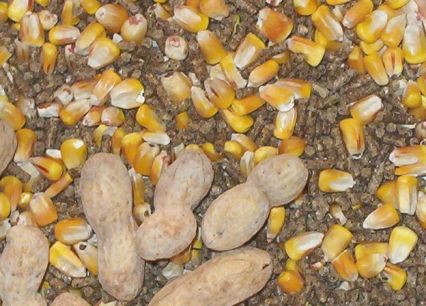
Working Goats are goats that work on a regular schedule. If you only take your goat packing once in a while you will not need to change their feeding schedule or calorie intake.
Many people make the mistake of feeding tooooo much grain to their goats and are indeed inviting more problems then actually helping the goat. Goats can become overweight pretty easily with too much grain and overweight goats (like people) are not healthy goats.
If your goats are packing every other week end or so, if your goats are packing more then 8 miles per day on a weekly trip, if your goats are carrying a good size load several days a week, week after week, it might need to have a grain supplement. Goats need very little grain, goats want lots and lots and lots of grain and treats. Don't let your goat "talk" you into thinking that it needs more then a cup a day of good quality grain. Fresh, good quality hay is what a working goat needs. Fresh clean water daily and a treat now and then.
Personally I use a goat food pellet and mix in a little corn. I however feed this, most of the time, from my hand as a reward or treat. And my goats get a peanut from my hand now and again too. <hint, most goats will do anything for a peanut>
Please Note: The photo of my mix has a bit higher corn then normal (I did not remember til we took the photo <smile> ) I am using this higher corn mix to bribe, I mean train, a few of my older goats...and they are a bit wiser <read more spoiled then the new babies> and will work more consistently for a higher percentage of corn.
WHEN YOU GET HOME FROM YOUR TRIP
So you are home from your packing trip. You goat, no matter how it really behaved, needs to know that you think it is the most wonderful animal on earth and that you appreciate the trip together.
Talk nice to your goat, give it treats and a good brush down and grooming. Give your goat a special meal after a fuss is made over it.
You also need to care for your packs. Clean any parts that need cleaning. All packs can be spot cleaned with a wet wash cloth, many can be thrown into the washing machine, hang to dry. Check the packs seams to make sure they are still in good repair. Check your pack for holes or wear areas. If any repairs do need to be made, do it right away. I you put this off, you might be terribly disjointed the next time you are packing to go on a Pack Trip.
Check your straps for pulling away from the pack, for wear areas and for fraying. Check all your buckles and rings too. Run a wash cloth over your straps just to pull the dirt that has built up from the trail off so that the straps will not wear out. Leather straps need to be cleaned and oiled once a year or so with horse saddle cleaning supplies.
Wash your camping/packing items and put them with your packs. Make sure your flashlight batteries are still good and buy new ones (or remember to recharge some for your next trip).
OTHER ANIMALS ON THE TRAIL
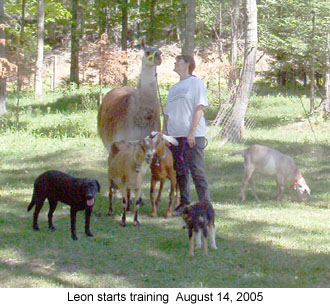
It does not matter where you backpack with your goats, country or county, mountains or bike trails, you will run into other animals, some wild, some domestic. Most of the time your worse encounter will be domestic dogs. You may have to defend your animals from an attaching dog. Worse then a loose dog coming for your animals is it's owner. Somehow, dog owners that do not have control over their dogs, seem to blame everyone and everything else for their animals bad behavior.
Overnight trips will bring out more wildlife and maybe right up to or into your tent. Skunks can be your worse nightmare. Not only will they spray you, your tent, camping gear, but also your goats.
It is not just four legged animals either....children and stupid people can pose a real threat to your animals and your safety. There is nothing worse then a spoiled child approaching your animals as you tell them no with their parent telling your "Oh it's alright, they just want to pet your animals." You must be firm and tell the child and the parent to either get back or wait until you are right beside your animals (especially important if your goats have horns).
This is one of the reasons you need to keep your animals right with you. If you have a dog of your own with you do not let it venture out into the woods, it might just bring a bear or other animal back at you chasing it off. Many times your actions and the actions of your own animals will make or break the situation from other animals, wild or domestic. Keeping your animals under control, being ready for a dog attach, keeping food put away in camp, make all the difference in the world.
You might think about carrying a small can of tomato paste (small camping can opener) and a bit of peroxide in your pack to clean up skunk smell from yourself, your equipment and your animals.
much more to come here
BACKPACKING TRAIL ETIQUETTE
FIRST AND MOST IMPORTANT!! THERE IS NO PLACE CALLED "IN THE WOODS". ALL WOODS, ALL LAND, IS OWNED BY SOMEONE. MAKE SURE YOU HAVE PERMISSION TO BE ON THAT LAND. IF IT IS A PARK, YOU WILL STILL NEED TO MAKE SURE THAT GOATS ARE ALLOWED!
Sharing the trail with others. <deep sigh> Here is where people can get into big fights out on the trail. Most don't, most will heed even if they have the right of way.
Let me see if I can remember all of this.....
Horses, Mules, Donkeys, ie ALL Equine always have the right away. You must get off the trail and stop moving for them. Far off if that is what it takes. It does not matter if they came up behind you and are passing or if they came from the opposite direction. Remember that many horses may have never seen a goat, especially one in harness or pack and the horse may spook. To help the riders, get your goats off the trail and try to turn the goats facing the other way away from the horses.
Next right away goes to any packing animals, llamas, donkeys, goats, dogs, any packing animals. This includes human packers. It does not matter if it is one person or a group.
Bicycles, I believe are next in the line up for right away on the trail.
People with dogs are suppose to keep them on leashes unless it is their own property or a dog park. There are very few places where dogs are allowed freedom of movement anymore....and less all the time. Dogs are to get off the trail for all of the above trail users. So if you are traveling with a dog with you, this pertains to you.
When you get to where you will be camping, take care of your animals first. Find your area, unpack and groom out the animals.
more to come
AGE TO START YOUR GOAT UNDER PACK
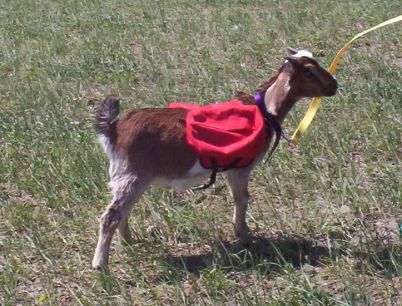
It is a great idea and good training to have a small pack and put it on your baby goats. Let them get a feel for the panniers/day pack on their back, the straps on their body, and the sway of the pack as they walk. Don't put anything heavier then loosely crumbled up newspaper (to fluff out the pack) inside the packs. Let the little guys carry this for short walks and make a big deal out of them as they do. Treat your babies as they will be treated on the trail, meaning, brush out their coats, look at their feet and all before adding their light as air pack. When you take the pack off, give them a rub down, brush them out, give them a treat....make this pack carrying thing a wonderful thing in their little eyes. That is how you start a young or baby goat to pack, by making it a fun time with you, almost a game.
I think the answer to what age can a goat carry an overnight load pack is like horses and age for riding.........some horses can be ridden at 2 y/o. Some groups of people insist that a horse be ridden at 2 y/o, while other trainers want to ground break and only ride them after 3 to 4 y/o. Then there are the breeds to consider.....like the Arab bred horses that mature slowly and knees can be done an injustice if ridden too early, so some goats. Which breeds of goats? I honestly am not that familiar enough with each goat breed to answer that question intelligently.
I do however think a goat can be taught to Pack at one year old or even much younger. Teaching a goat to carry a light weight daypack is good foundation training practices. When to add weight to the pack and how much to add.........well that is a can of beans that every goat packer/trainer will probably answer differently. Me? I add weight to my animals slowly, probably much slower then the average trainer.
For me, there is so much more then age of the animal involved. After the goat is one year old and around two years old the goat really has to be evaluated before adding too much weight to it's pack.
Is the goat in good health? Are it's legs not only straight but also strong from more then just moving around in a small pen? What is the goats conformation like? How are it's manners? Is it in heat? Has the goat carried a light weight pack over many different types of footings/ground to learn to move around trees and to brace it's self going down hill? Has the goat been walked/hiked in the woods and on trails? Will the goat walk through water filled streams and large puddles? Has the goats hooves been trimmed? You do not however want to trim the goats hooves right before it starts packing wights?
If you want your goat as a trail companion for many years to come, don't get in a hurry when it is young. Like a young football player, it can and will try to do the job, but it's body will suffer for it for years to come.
Before adding much weight to the goat's pack I work the beginner packer up to that weight. I start by adding a bit more weight daily (if you train daily LOL)and also add distance to the hike every day.
Personally, to me, goats are like, well you know. Bring the pay off (treats) and they will try anything. A baby goat will pack a large and heavy load for a treat, or at least try to. There is no rocket science to training a goat to pack or go goat packing. The burden, as they call it, to me lays on the owner/trainer for the goats health and safety. But, when you goat does work for you.....do need to give the pay off.
PACKING DURING HUNTING SEASON
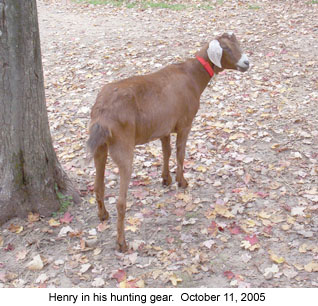
First and foremost, the hunters have waited all year for their sport season, if you can at all do not plan a packing trip during hunting season.
As important, if you are out on the trail with or without your goats, bright orange clothing is a must. It is not an option. Orange clothing are a must. You may not want to be seen, but think about this. A hunter may shoot your butt if you are wearing brown, black, red (turkeys), blue (birds). So wear orange.
If you are taking your goat hunting with you, there is much to plan for before thinking a goat, any goat, will be fine to go hunting with you. The goat must learn not to be gun shy. You will need to shoot your gun around the goat so that it will not spook when you are hunting. Your goat will need to see, smell and learn about "meat". To them, it is a dead animal and they will want to avoid it, not carry it.
You are responsible for your animals safety in the woods any date you go, during hunting season that responsibility increases. Not only will your goats be exposed to the game you are after but perhaps predators. If you are too busy hunting to keep an eye of them for their safety, please do not take them with you. I read on a website that a guy, while hunting for elk, leaves his goats tied while he hunts. Let's think, in elk country there are also grizzly bears, big cats/cougars, wolves, coyotes and other animals that when hungry will be so glad you left those defenseless goats who are no match against these wild animals and that you left them tied down to boot. And if that does not bother you, how about carrying your pack, your game and everything your now dead goat carried out there for you back by yourself.
When packing with animals while hunting you might want to use different panniers then you would on a group goat packing trip. Polar Fleece panniers will be much more quiet then the cordora, canvas or nylon bag you might normally use. If you are a lucky hunter, blood will also be an issue to think about with your regular bags/panniers. Also if your packs are say blue, they will not be safe for your goat to wear and you will surely want to buy/make/borrow bright orange. Red packs are not ok to use. If you have ever been to a gun safety class they will tell you red can not be seen as well as the orange and red is a color that some hunters look for in game. Bright, Neon and or Hunter Orange, those are the colors of packs/panniers and other equipment that you will need for taking a goat hunting with you.
If you take your goat hunting with you during the Deer and in my case Antelope season. If your goat might look like the prey, your animals will need to wear bright orange in camp as well as be kept right with you in camp. As you can see from this photo, bright orange collars are nice, but for the woods in hunting season, not near enough to be identified as a pack or pet animal.
To get blood out of or off of your equipment and or packs and clothing use peroxide. Let it bubble up and remove the blood then wash and dry your items as always.
Carrying antlers can be a dangerous thing. The bigger they are, the more dangerous they can be. If you put antlers on your goat to pack and they look like the even might, even just a little, look like the animal is attached to them, you have just made your goat a target in a crosshairs. Always, always, always remember, no matter who carries the antlers, carry them upside down and low. Also, always, wrap them with hunter orange or place them on something with hunter orange, but not your coat!
Most hunters carry their guns on a gun strap/sling. Just make sure that the barrel is not pointed toward you goats (even when unloaded and with safety on). You could pack your guns on your goats, but it is probably not a good idea.
And of course, don't forget to take that bell off your goats collars and packs or they will alarm the prey that you are on your way out and coming with a gun.
Have fun, but be safe. There is still no real way to "undead".
PACK MAINTENANCE
You must take care of your equipment and check it often for wear, holes, frays, build up of dirt, burns or other stresses to seams or the like. If that pack or pannier breaks on the trail, guess who will be pickup up the equipment and carrying it back to your vehicle?
You should really take a few minutes and check your packing gear while on the trail at camp. It will only take a minute and may save you hours. Just do a quick check over and run your finger over the inside seams of your packs. Always carry a sewing kit with you but make sure it is in a good thick plastic container that closes tightly so that needles do not get loose in the pack and hurt someone. Empty vitamin jars are great for this. Duct tape can also be very helpful if your saddle, straps or even seams break or come loose.
Hang your sawbuck saddle and or panniers over a branch in camp. If there is no where to hang them safely, put them and any other equipment inside your tent. If your sawbuck would get stepped on it could break, a person could get their ankle or leg or foot hurt and a goat could get twisted in between the top bars and get hurt. Goats are curious animals and will nose around anything you leave out and where they can get to them. Keep that in mind with all of your belongings.
When you get home from your trip, even a short little lunch trip, check your equipment over really well. Check all of your buckles, buckle holes, and or places where the webbing or straps are stressed as the animal walks the trail. Clean your equipment up, some packs might need a good machine washing, others just wiped over, check it out and store it correct. Packing equipment is not only expensive, it needs to be where you can find it and ready to go when you are.
You should also check your equipment when you pull it out to use again. You never know when a sneaky little mouse may get into things and build nests, chew and destroy items.
Repairing your Pack or Pannier If you repair your own packing equipment be sure to really nail down your seams. Double stitching may not be enough. Packing trips can really be hard on some equipment with some animals. Some packs will be scrapped on trees, chewed at, gone through water crossings, as well as the usual wear and tear. Keep in mind the wear that the type of pack/panniers will be receiving and repair accordingly.
If you patch a pannier, cut your patch out of heavy duty fabric as close to matching the fabric as you can. I fold the fabric over just a bit for the patch. Sew it in place from the outside of the hole tucking your pannier (where the hole is) as you go so that the pannier will not fray further. You might need to clip your corners on the pannier for this. Sew it at least double then go right along the seam with a zig zag stitch. Now sew the inside of the patch (sew from the other side of the pack). Double your patch over where necessary and tuck it under a bit so that it too does not fray. Sew it down close to the ends of the fabric. Zig Zag it too, this helps keep items from rubbing it when the goat walks with a load in it. If it is a large patch make a sewn X from one corner to the other for strength.
Don't think of your pannier as worn and torn, think of it as broke in and has character! Patches on panniers are like scars in the body, kinda like a tattoo only with a much better story!
WHAT YOU MIGHT PACK OUT
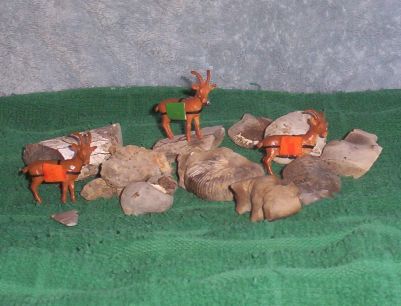
"Packing out" is what is known as things you carry home with you. Along with all of your belongings including all of your trash and dirty clothes, you might find a rock or two you would like to own.
If you are on public property you probably can not take it with you. No rocks, no fossils, no flowers, no seeds, nothing that others might enjoy on their next trip. Those items are to be left behind by law.
However, if you are on private property or your own property or even some, very few, but some public properties, you might be able to carry off rocks, fossils, arrrowheads, and other interesting items.
Check the rules, sometimes laws, in the areas you go packing. You might find not only can you not take those rocks with you....you do have to pack out your own poop.....nope, not kidding! (' ') ')
Can My Free Goat Pack, Pull and/or Do Tricks?
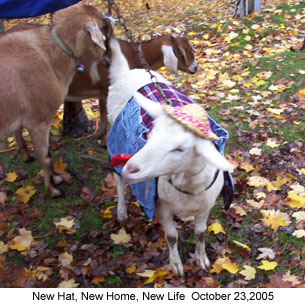
I hear/am asked this a lot. Someone gave a person an adult goat and the person receiving it has big plans but no experience with goats. Can it work? YOU BET!!
However you do need to look at several facts... Is it an older unhandled buck? How old is it? Is it friendly? Is it a healthy animal? Has it been cared for? How are it's hooves, well trimmed? How is it about being handled and having it's feet handled? Do you own other goats already? Does it get along with other animals?
Never say yes to a free animal until you have gone to see it and have asked many questions. FREE can mean it will cost you much in emotions and cash (vet bills, hospital bills, repair jobs (fencing, barn, house, clothes). Always ask why they are getting rid of it and follow that with back up questions.
The goat in the photo to the right is DragonFly. She was given to me free from a good friend who knew I was looking for a goat. Sharon has given me several animals and when you get an animal from her it is solid! Solid meaning, friendly, healthy, well broke and desensitized and ready to go do what ever it is you want it to do. This photo was taken either the day DragonFly came home with me or shortly after. This goat has done about everything and then some, a gives a good amount of milk when freshened too.
But many times, I would venture most times, the free animal has not been worked with. It was probably bought as a kid and while it was little and cute they let it get away with cute things like butting people, jumping on vehicles, pushing the family dog around and the like. Now it is full grown and a pain in the butt head! So it will take a lot of work just to make this type of goat a pet and or companion, not alone a working animal. It can be done, but it will take a lot, a whole lot of love and patience and training and patience and time and patience and for the average person, it will not be worth the work it will take.
CHECK BACK, WE ARE STILL WORKING ON THIS PAGE
-- The Working Goats Team
Fri, 03 Apr 2009 20:15:11 -0400
| 



 In the high plains of South Dakota, USA
In the high plains of South Dakota, USA In the high plains of South Dakota, USA
In the high plains of South Dakota, USA